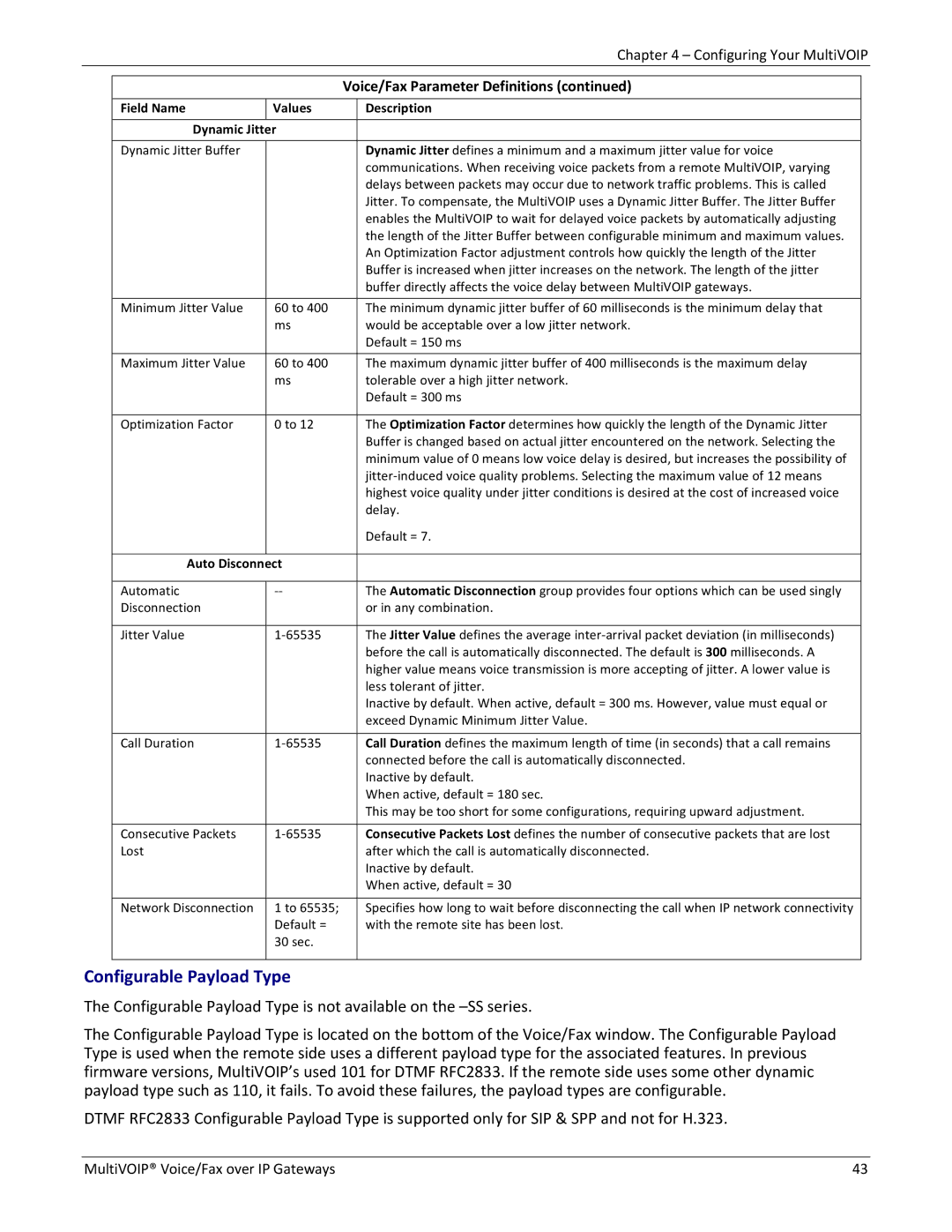
Chapter 4 – Configuring Your MultiVOIP
Voice/Fax Parameter Definitions (continued)
Field Name | Values |
|
|
Dynamic Jitter
Dynamic Jitter Buffer
Minimum Jitter Value | 60 to 400 |
| ms |
|
|
Maximum Jitter Value | 60 to 400 |
| ms |
|
|
Optimization Factor | 0 to 12 |
Auto Disconnect | |
|
|
Automatic | ‐‐ |
Disconnection |
|
|
|
Jitter Value | 1‐65535 |
Call Duration | 1‐65535 |
Consecutive Packets | 1‐65535 |
Lost |
|
|
|
Network Disconnection | 1 to 65535; |
| Default = |
| 30 sec. |
Description
Dynamic Jitter defines a minimum and a maximum jitter value for voice communications. When receiving voice packets from a remote MultiVOIP, varying delays between packets may occur due to network traffic problems. This is called Jitter. To compensate, the MultiVOIP uses a Dynamic Jitter Buffer. The Jitter Buffer enables the MultiVOIP to wait for delayed voice packets by automatically adjusting the length of the Jitter Buffer between configurable minimum and maximum values. An Optimization Factor adjustment controls how quickly the length of the Jitter Buffer is increased when jitter increases on the network. The length of the jitter buffer directly affects the voice delay between MultiVOIP gateways.
The minimum dynamic jitter buffer of 60 milliseconds is the minimum delay that would be acceptable over a low jitter network.
Default = 150 ms
The maximum dynamic jitter buffer of 400 milliseconds is the maximum delay tolerable over a high jitter network.
Default = 300 ms
The Optimization Factor determines how quickly the length of the Dynamic Jitter Buffer is changed based on actual jitter encountered on the network. Selecting the minimum value of 0 means low voice delay is desired, but increases the possibility of jitter‐induced voice quality problems. Selecting the maximum value of 12 means highest voice quality under jitter conditions is desired at the cost of increased voice delay.
Default = 7.
The Automatic Disconnection group provides four options which can be used singly or in any combination.
The Jitter Value defines the average inter‐arrival packet deviation (in milliseconds) before the call is automatically disconnected. The default is 300 milliseconds. A higher value means voice transmission is more accepting of jitter. A lower value is less tolerant of jitter.
Inactive by default. When active, default = 300 ms. However, value must equal or exceed Dynamic Minimum Jitter Value.
Call Duration defines the maximum length of time (in seconds) that a call remains connected before the call is automatically disconnected.
Inactive by default.
When active, default = 180 sec.
This may be too short for some configurations, requiring upward adjustment.
Consecutive Packets Lost defines the number of consecutive packets that are lost after which the call is automatically disconnected.
Inactive by default. When active, default = 30
Specifies how long to wait before disconnecting the call when IP network connectivity with the remote site has been lost.
Configurable Payload Type
The Configurable Payload Type is not available on the
The Configurable Payload Type is located on the bottom of the Voice/Fax window. The Configurable Payload Type is used when the remote side uses a different payload type for the associated features. In previous firmware versions, MultiVOIP’s used 101 for DTMF RFC2833. If the remote side uses some other dynamic payload type such as 110, it fails. To avoid these failures, the payload types are configurable.
DTMF RFC2833 Configurable Payload Type is supported only for SIP & SPP and not for H.323.
MultiVOIP® Voice/Fax over IP Gateways | 43 |
